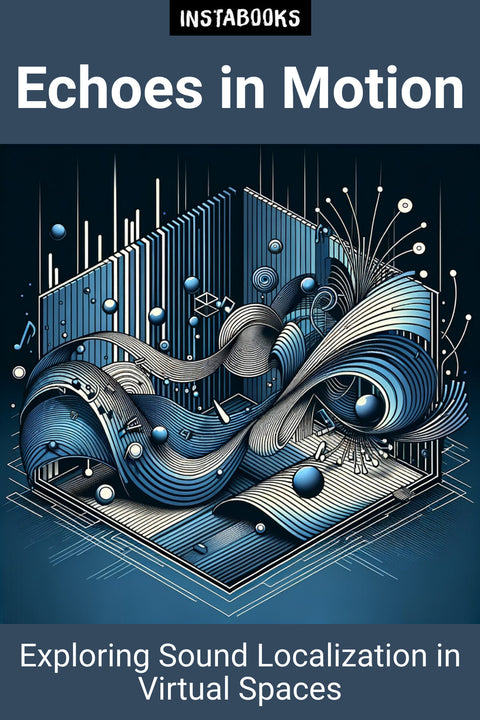
Echoes in Motion
Exploring Sound Localization in Virtual Spaces
Included:
✓ 200+ Page AI-Generated Book
✓ ePub eBook File — read on Kindle & Apple Books
✓ PDF Print File (Easy Printing)
✓ Word DOCX File (Easy Editing)
✓ Hi-Res Print-Ready Book Cover (No Logo Watermark)
✓ Full Commercial Use Rights — keep 100% of royalties
✓ Publish under your own Author Name
✓ Sell on Amazon KDP, IngramSpark, Lulu, Blurb & Gumroad to millions of readers worldwide
Introduction to Sound Localization
"Echoes in Motion: Exploring Sound Localization in Virtual Spaces" delves into the fascinating world where auditory perception meets virtual technology. At its core, this book examines the intricate dance between self-motion, room familiarity, and multisensory integration in virtual environments. Whether you are an audiophile, a virtual reality enthusiast, or a researcher, this comprehensive guide offers insights and understandings critical to mastering sound source localization.
Unveiling Self-Motion Effects
The book begins by exploring groundbreaking research on dynamic head movements, highlighting how these enhance auditory localization accuracy. Readers will discover how lateral horizontal self-motion aids distance perception, while delving into the complexities around azimuth perception and room familiarity.
Adapting to Room Acoustics
Next, "Echoes in Motion" takes you on a journey through familiar environments, focusing on the significant influence of room acoustics. As you progress, you'll learn about the dual nature of familiarity—its potential to improve or hinder spatial hearing. The book emphasizes the adaptation process essential for optimizing auditory localization.
Integrating Multisensory Experience
With precision and clarity, this book unpacks the realm of multisensory integration. It investigates how visual and auditory cues in virtual reality contribute to sound localization. Cross-modal relationships and their implications on psycho-acoustic judgments offer readers an enlightening perspective on the synergy between our senses.
The Technological Edge
Finally, the book includes cutting-edge technological approaches like WebVR and machine learning techniques. "Echoes in Motion" presents a detailed analysis of these innovations that are shaping the future of sound localization. It discusses how careful selection of environments and sophisticated methodologies enhance this auditory art form.
This book bridges technology with psychology, science with art, creating an essential resource for those looking to deepen their understanding of auditory perception in virtual realms.
Table of Contents
1. The Foundations of Auditory Perception- Understanding Sound Localization
- Role of Auditory Cues
- Psychoacoustic Principles
2. Dynamic Motion and Localization
- Head Movement Insights
- Lateral Motion Effects
- Challenges in Azimuth Perception
3. Familiarity Breeds Acuity
- Room Acoustics Adaptation
- Spatial Hearing Variations
- Balancing Familiarity and Novelty
4. The Multisensory Landscape
- Cross-Modal Integration
- Visual and Auditory Synergy
- Sensory Enhancement Techniques
5. Harnessing Technology
- WebVR Innovations
- Sound Localization Experiments
- Machine Learning Applications
6. Advanced Auditory Techniques
- Binaural Sound Processing
- 3D Audio Modeling
- Real-time Auditory Feedback
7. Designing Virtual Audio Spaces
- Architectural Acoustics
- Virtual Room Dynamics
- Interactive Audio Design
8. Real-World Applications
- Gaming and Entertainment
- Virtual Training Programs
- Therapeutic Uses of Sound
9. Challenges and Future Directions
- Overcoming Localization Barriers
- Emerging Research Trends
- Future Technological Prospects
10. Case Studies in Virtual Environments
- Experimental Design Frameworks
- Analysis of User Experience
- Comparative Studies and Findings
11. The Psychology Behind Sound
- Cognitive Processing of Audio
- Memory and Sound Recognition
- Emotional Impact of Auditory Stimuli
12. Conclusion and Insights
- Summing Up Key Learnings
- Practical Applications
- Final Thoughts on the Future
Target Audience
This book is for researchers, audio engineers, and virtual reality developers keen on understanding sound localization dynamics. It's also suitable for tech enthusiasts and professionals in immersive technology fields.
Key Takeaways
- Understand the role of self-motion in enhancing sound localization.
- Learn how room familiarity affects auditory perception.
- Explore multisensory integration's impact on sound localization.
- Gain insights into technological advancements like WebVR and machine learning.
- Apply sound localization knowledge to real-world virtual environments.
